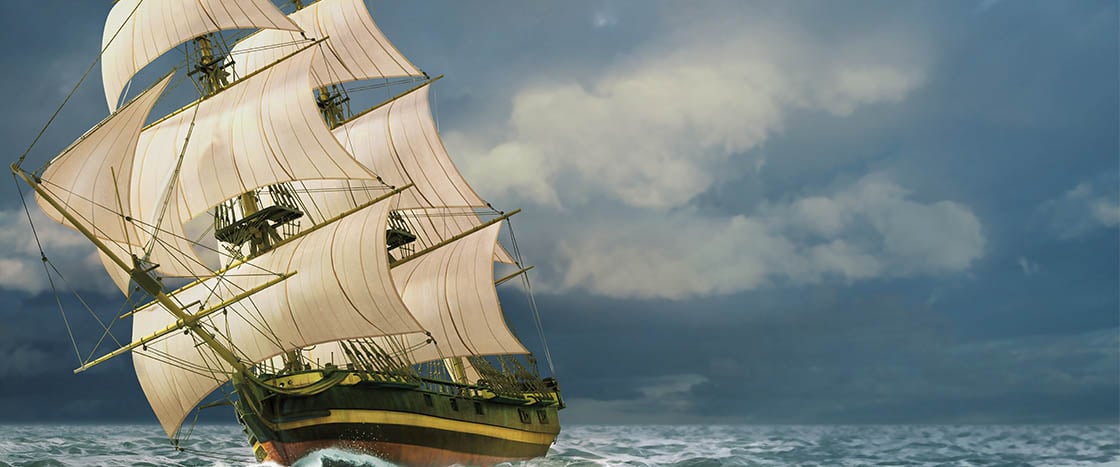In early 1717, a pirate named Sam Bellamy and his men prowled the Caribbean Sea and the Atlantic Ocean. They were there to rob passing ships full of gold, silver, silk, and spices.
Bellamy was a very successful pirate. He had 145 men on his crew. In just one year, they had robbed more than 50 ships.
That April, Bellamy and his crew were sailing north on a big ship called the Whydah. They were going to their hideaway off the coast of Maine. The Whydah was filled with treasure. This included 180 bags of gold and silver coins.
Along the way, Bellamy ordered his men to stop on the shores of Cape Cod, Massachusetts. He had a girlfriend to visit there.
But Bellamy never made it. On April 26, the Whydah was just 500 feet from shore. A vicious storm swept in. Thirty-foot waves crashed over the ship. Howling winds tore apart sails. They toppled men like toy soldiers.
The Whydah broke apart. Men tumbled into the sea. Sam Bellamy drowned. He was one of 140 men who died that day. The ship’s wreckage settled at the bottom of the ocean. That was more than 300 years ago.
Barry Clifford grew up on Cape Cod, at the tip of Massachusetts. When he was a kid, his Uncle Bill loved telling him the story of a pirate who lived in the 1700s. That pirate’s name was Sam Bellamy. Bellamy sailed a ship called the Whydah. He had a crew of 145 men with him. They would rob the ships that passed by. They’d steal gold, silver, and spices.
On one April day, the Whydah was filled with 180 bags of gold and silver coins. But then a bad storm hit. Waves crashed over the Whydah and broke the ship apart. Sam Bellamy died. So did most of his crew. The ship sank to the bottom of the ocean.
But what happened to the gold and silver?
In 1717, a pirate named Sam Bellamy and his men sailed the Caribbean Sea and the Atlantic Ocean. They were there to rob the ships passing by. They stole gold, silver, silk, and spices.
Bellamy had 145 men on his crew. In just one year, they had robbed more than 50 ships.
That April, Bellamy and his men were sailing on a big ship called the Whydah. They were going to their hideaway near Maine. The Whydah was filled with treasure. This included 180 bags of gold and silver coins.
Along the way, Bellamy told his men to stop on the shores of Cape Cod, Massachusetts. He wanted to visit his girlfriend.
But Bellamy never made it. On April 26, the Whydah was just 500 feet from shore. A vicious storm swept in. Tall waves crashed over the ship. Howling winds tore apart sails. They toppled men like toy soldiers.
The Whydah broke apart. Men fell into the sea. Sam Bellamy drowned. He was one of 140 men who died that day. The ship’s wreckage sank to the bottom of the ocean. That was more than 300 years ago.
The year 1717 began very well for a pirate named Sam Bellamy. He and his men had been prowling the waters of the Caribbean Sea and the Atlantic Ocean. Their prey was ships traveling between the Caribbean islands and England—ships laden with gold and silver and silk and spices. Bellamy had 145 men in his crew and a fleet of five stolen ships. Their best ship was the Whydah, which Bellamy and the crew had recently taken from English slave traders. The ship was big, fast, and sturdy. Terrified ship captains surrendered quickly when they saw the Whydah on their tails, its black flag raised, its huge cannons ready to fire. They expected Bellamy and his men to steal their ships and kill them all.
But Bellamy wasn’t a murderer. He was a thief, and a very successful one. In just one year, Bellamy and his men had looted more than 50 ships. By April 1717, the Whydah was filled with plundered treasures, including 180 bags of gold and silver coins. It was time to head to their hideaway: an island off the coast of Maine. There, they would divide up their booty and head their separate ways.
As the fleet sailed north, Bellamy ordered the Whydah to make a stop on the shores of Cape Cod. He had a girlfriend there, a farmer’s daughter named Maria Hallett. Some say the blue-eyed Maria and the black-haired pirate planned to marry, and Bellamy wanted to delight his future bride with a glimpse of his new treasures.
Whatever lured Bellamy to the Cape, he never made it. On April 26, when the ship was just 500 feet from the shores of the Cape town of Wellfleet, a vicious storm swept in. Thirty-foot waves crashed over the Whydah’s decks. Howling, 70-mile-per-hour winds tore apart sails and toppled men like toy soldiers. The pirate crew struggled to keep the ship under control and away from the rocky shore. But suddenly, a monstrous gust of wind took hold of the Whydah and sent it slamming into a sandbar. The ship broke apart. Hammering waves finished the job. Men tumbled into the sea as massive cannons and wooden masts came crashing down over them. One hundred and forty-four men drowned, including Sam Bellamy. Within days, the ship’s wreckage had slipped off the sandbar and settled at the bottom of the ocean.

